Last Updated on December 15, 2024 by Owen McGab Enaohwo

As a founder, no one knows the changes you want to effectively plan, implement, and track within your business better than you. However, sometimes tracking these business processes and systems with the right and appropriate tools can be tough.
With many change management tools promising seamless services, knowing the best organizational tool to drive the best results gets trickier. So, what tool is best for your business?
This post provides all the help you need. We have carefully selected the top 11 change management tools and dived deeper into SweetProcess, the major software for managing organizational change.
Get started with SweetProcess today by signing up for a free trial.
Here’s What You’ll Learn In This Guide:
What Is a Change Management Software?
11 Best Change Management Tools for Businesses
8 Benefits of Change Management Software
7 Things to Consider Before Choosing a Change Management Software for Your Business
How Companies Implement Organizational Changes Using SweetProcess
Which Change Management Platform Is Right for Your Company?
What Is a Change Management Software?

Change management software is a tool custom-made to plan, monitor, and implement change in companies.
These tools provide companies with a structured approach to dealing with all the steps and phases involved with change, from the first request to the final implementation and evaluation.
This facilitates seamlessly switching to new systems and processes or introducing recent technology into employee workflow.
How about trying SweetProcess for 14 days for free? No credit card is required.
11 Best Change Management Tools for Businesses
Here are our top change management software and tools picks for your business.
1. SweetProcess: Best For Organizational Change Management

SweetProcess tops the chart as the best user-friendly change management software. This process management tool documents, tracks, and simplifies standard operating procedures (SOPs), policies, and business processes.
It is a reliable tool for documenting and managing certain aspects of change management processes, such as creating and sharing change requests or documenting new procedures.
SweetProcess is the ideal solution for businesses looking to streamline their operations, improve efficiency, and empower their teams.
Teams and anyone seeking to improve their business processes benefit greatly from this change management tool.
Core Features of SweetProcess
Document Creation
SweetProcess is a change management tool that lets you smartly create and plan step-by-step standard operating procedures, policies, and checklists. Liston Newton Advisory company got the help it needed to streamline its procedures and policies. Now, it has moved past chaos, all thanks to SweetProcess.
Collaboration
SweetProcess fosters teamwork. It facilitates seamless collaboration through commenting, version control, and real-time updates. This way, the team is abreast of all the happenings and can track and monitor all the procedures and policies.
Task Management
One thing that SweetProcess does well is its effective task management. Maxwell Counters, a company that fabricates, installs, and replaces countertops, uses it to seamlessly assign tasks, track progress, and set deadlines to ensure accountability.
Knowledge Base
With SweetProcess, building a common repository of knowledge that is accessible to your entire team is possible more than ever. No more leaving any team member in the dark with tasks and task management. It also fosters a culture of knowledge-sharing and collaboration.
Onboarding New Hires
SweetProcess facilitates your company’s onboarding process with clear SOPs and checklists. You can also identify and address inefficiencies through process documentation and analysis.
How to Use SweetProcess as Your Change Management Software
SweetProcess comes in handy to effectively streamline and manage various aspects of the change management process in your business. Some of the ways this could be done include:
Documenting Change Procedures
With SweetProcess, you can develop clear and concise standard operating procedures for each stage of the change management process, from initiation to closure. This means defining roles and responsibilities, aptly defining the roles and job descriptions of everyone involved in the change process, and establishing approval workflows.
Managing Change Requests
SweetProcess is used as a central knowledge base for all change requests. This makes seamless identification of change requests and effective tracking of progress through the approval and implementation phases easy. Furthermore, you can also set deadlines and reminders to ensure timely completion of change tasks.
Facilitating Collaboration and Communication
Change management requires real-time collaboration, and SweetProces helps with this. You can use it to make comments and annotations to facilitate discussions and feedback on change requests. This change tracking helps to effectively make updates, documents, and procedures to maintain a clear audit trail. You can also set up notifications to inform relevant stakeholders about changes and updates.
Knowledge Sharing and Training
Use SweetProcess to store necessary change management documentation, such as templates, checklists, and best practices. You can also use it to create training materials to educate employees on change management processes and procedures, monitor employee training completion, and assign follow-up tasks.
Track Key Performance Indicators
SweetProcess can play a huge role in your change management when you use it to track key performance indicators (KPIs) related to change management, such as change implementation time, success rate, and customer impact. You can also use it to create reports to analyze change management performance and identify areas for improvement.
How to Document Policies, Processes, and Procedures on SweetProcess
Change management involves accurately documenting policies, processes, and procedures. It also entails developing an instructions manual for employees to retrieve the needed information.
Here’s how to create a procedure in SweetProcess:
First, click “Procedures” and then click “Create Procedure.”
- Click on the “Policies” tab.
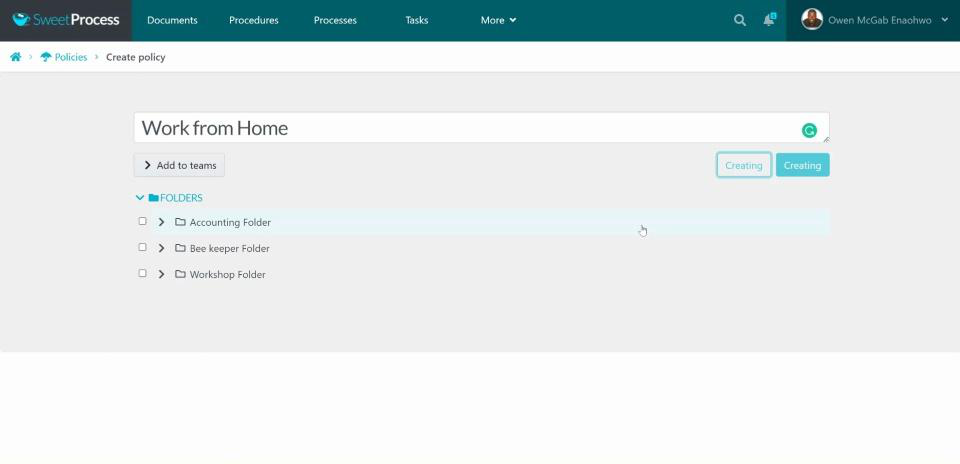
Next, type your procedure title and click “Continue.”



Now, click on the pencil symbol beside the title.
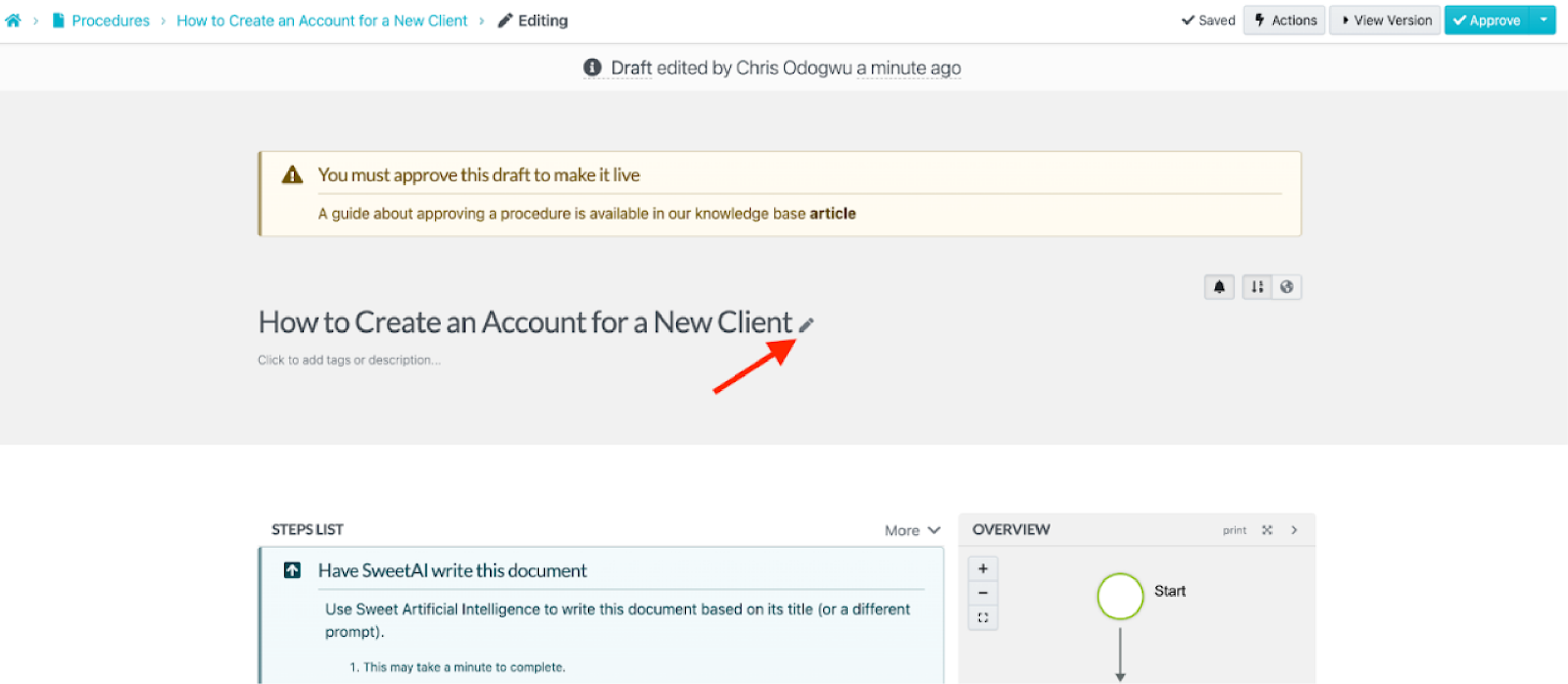
Fill out the details of your procedure in the content editor and click “Finished Editing.”

How to Write a Policy Automatically on SweetProcess Using AI
Let SweetAI help you document the first version of the policy so you can either approve or improve it from there. The instructions below will show you how to create a new policy using SweetAI so you don’t have to start from scratch.

- Once the page opens, click the “Create Policy” button on the top right-hand side.

- Next, enter the title of the policy.

- Now click on the “Write with SweetAI” button.

Wait a few seconds for SweetAI to generate the policy for you.
- Approve or Edit the Policy SweetAI Generated for You
Once SweetAI automatically generates a policy for you, you can approve it or add your finishing touches to edit it further.
How to Write a Procedure Automatically on SweetProcess Using AI
First, click “Procedures” and then click “Create Procedure.”


Write the procedure title in the space and click “Write with SweetAI.”

Wait a few seconds for the system to write the content based on your title.
Edit any section of the content by clicking on the pencil symbol.
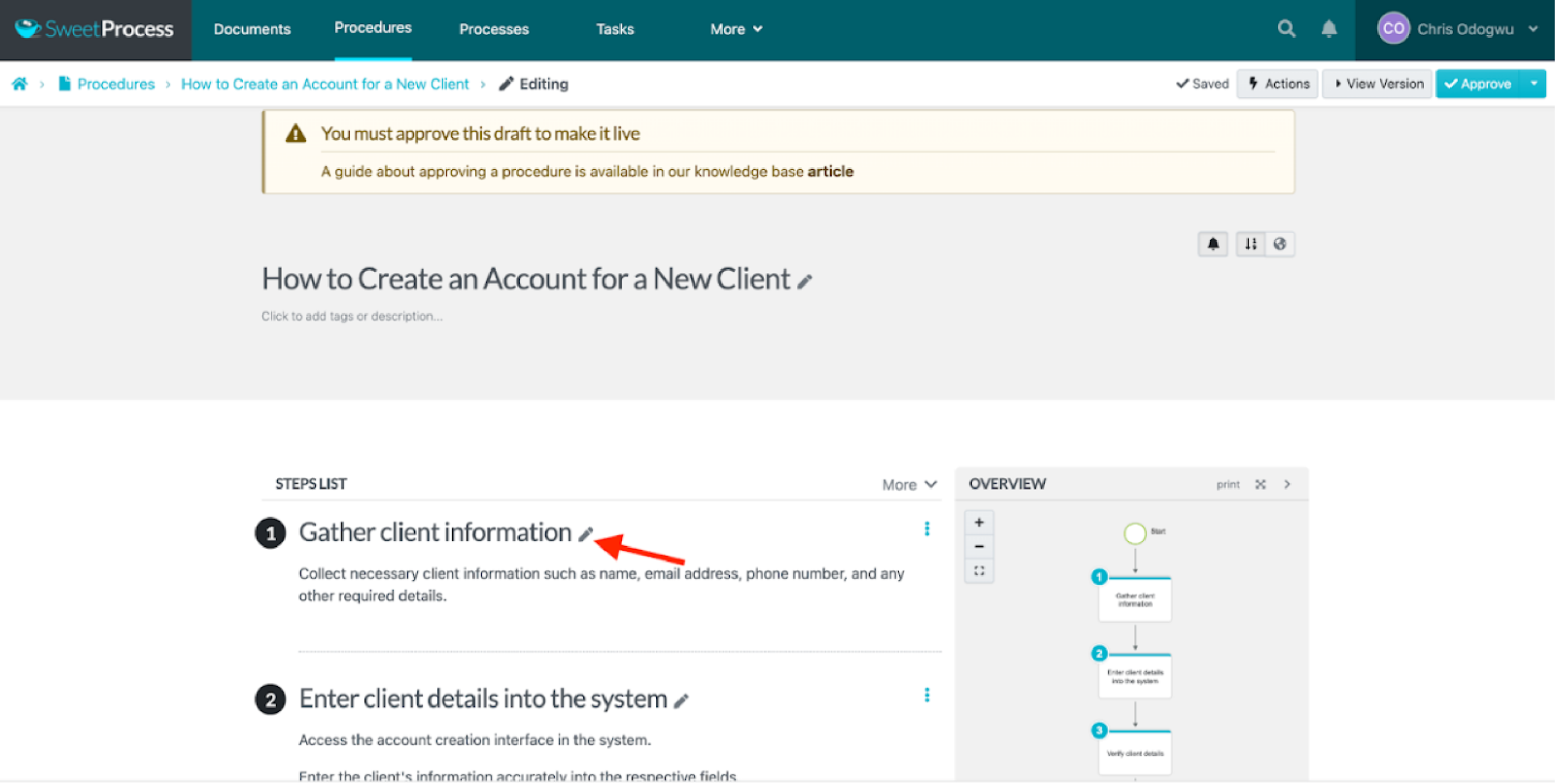
Click on “Approve” to publish the document.
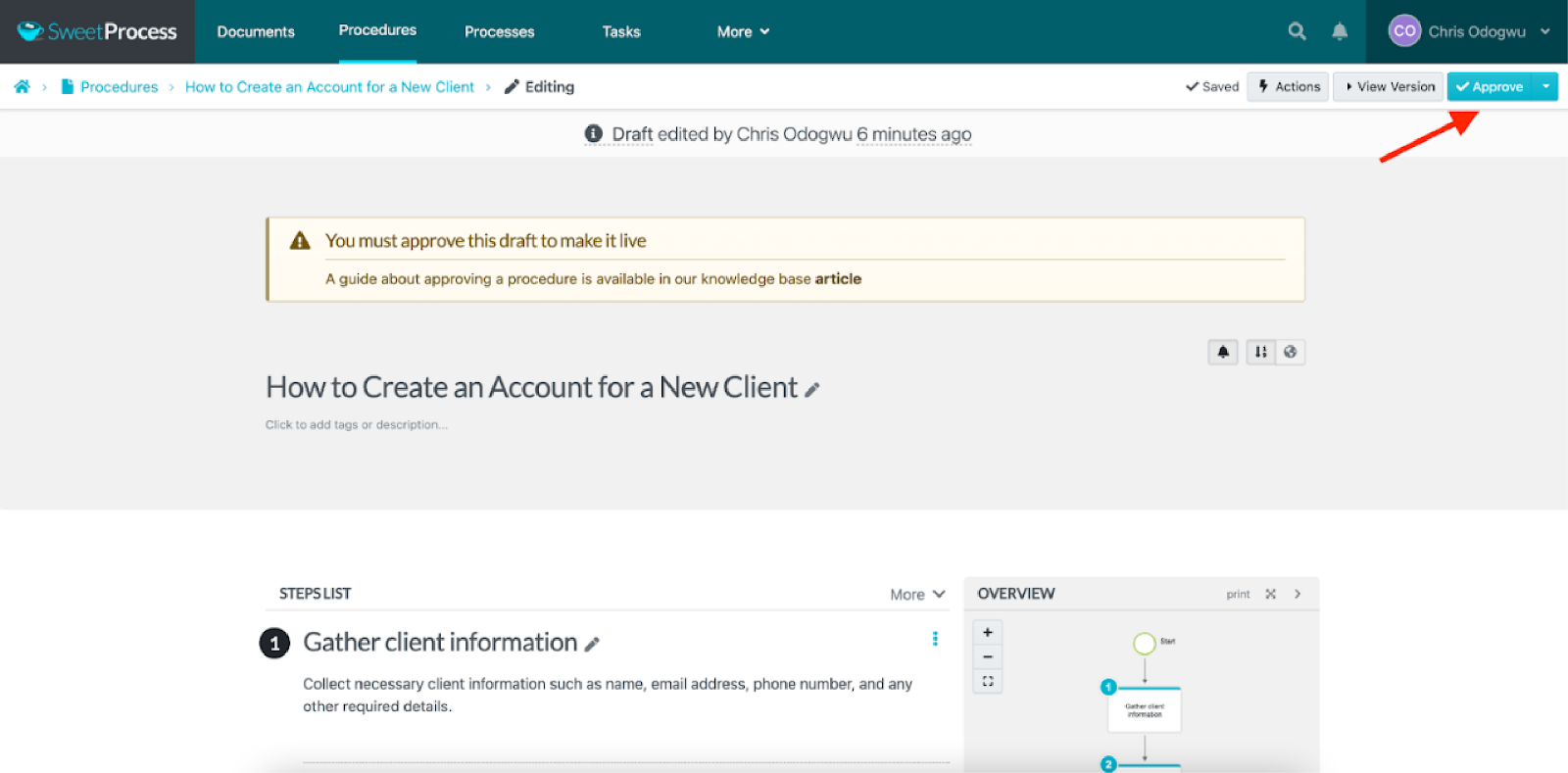
How to View the Version History of Policies, Processes, and Procedures in SweetProcess
View Version History of a Process
While viewing a process, click on the clock icon.

This opens the version history sidebar and the current versions.

After the version history sidebar menu opens up, click on the version of the process you want to see.
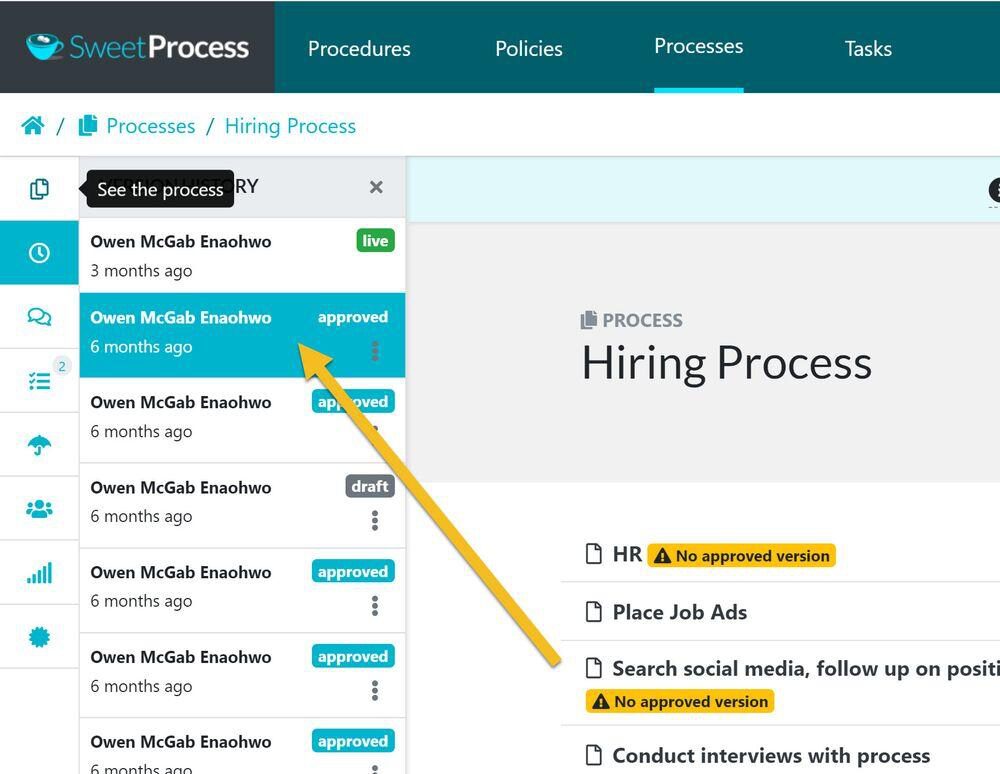
Version History of a Procedure
While viewing a procedure, click on the clock icon.

This will open the version history sidebar menu, which lists the current procedure version and all the other versions so far.

After the version history sidebar menu opens up, click on the version of the procedure you want to see.
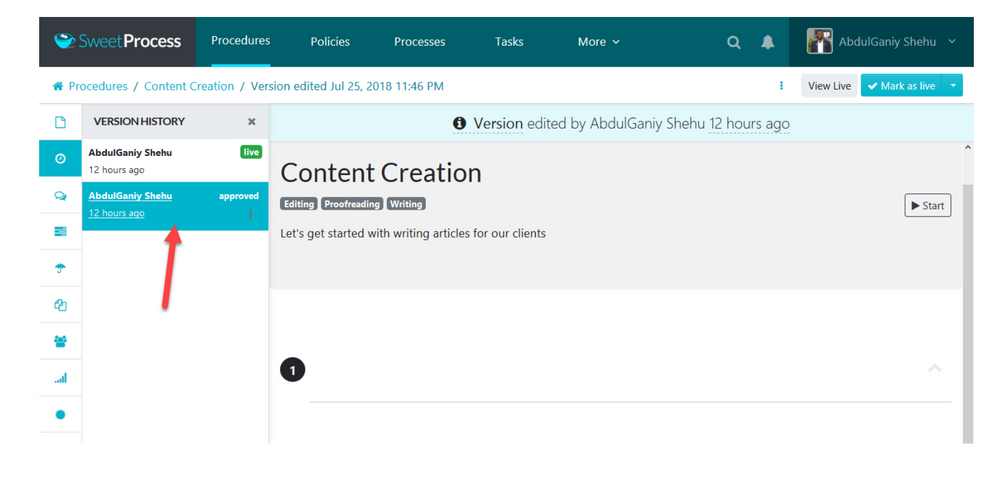
How to Manage Organizational Change on SweetProcess
Effective change management is possible when you start by documenting every process. This means all team members should first document and access all your procedures and work instructions. Consider your standard operating procedures, operational processes, employee onboarding, and industry policies.
How to Assign Tasks and Collaborate with Team Members on SweetProcess
As a founder or manager, you don’t have to overwhelm yourself by doing it all. A change management team should be set up to plan and implement the various change initiatives. You can have a standby or ad-hoc team who will be charged to ensure that any change process is handled properly.
Start by selecting the assigned task. Select the three-dot menu to the right of the procedure or process you want to assign.

Click on the “Assign as Task” option in the three-dots menu.
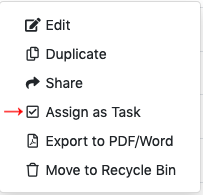
You can also assign a task while viewing the procedure or process itself from the “Actions” menu on the top right of the screen.
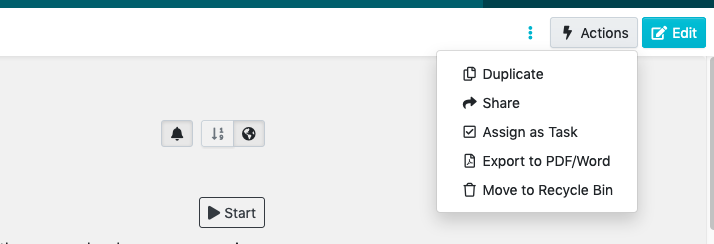
Next, select single or multiple tasks.

You can choose a single task assigned to a group to work on together or multiple tasks assigned separately to each teammate (assigning in bulk).
Find and select teammates to assign tasks to. You can also assign everyone in a team at once and everyone with a particular role. They could either work together as a team or be assigned separate tasks.
Now, fill out the rest of the task. The task name is a great way to differentiate this task from others based on the same procedure.
You can change the following:
- Due date: starting time (teammates will get a notification at the start time or due date if no start time is given)
- Repetition: You can enter repetition settings, such as every last Friday of the month, or basic ones like weekly, monthly, or yearly.
Tasks that repeat
By default, the task will simply be a “Once Only” task designed to be completed a single time and then finished. However, many tasks should be repeated every day, week, month, or year. SweetProcess supports a huge variety of repetition rules. Simply change the “Repeat” dropdown from “Once Only” to any other option:

Assign task
Now, go ahead and assign it. The teammates you have assigned will get a reminder email and a notification when the task is due or at the start time. You will also receive a notification when the task falls overdue and when it is marked complete.
2. Monday: Best for Workflow Automation

Overview of Monday
Monday is a powerful work operating system (Work OS) designed not for change management but to empower teams of all sizes to manage projects, workflows, and communication seamlessly. It goes beyond simple project management by offering a customized platform that adapts to your specific processes.
Features of Monday
- Plan tasks and projects using custom-made Kanban boards, timelines, and calendars.
- Automate repetitive tasks to save time and ensure consistency.
- Connect Monday with your favorite tools.
- Communicate directly within tasks, assign team members, and track progress together.
- Gain valuable insights into your team’s performance with custom dashboards and reports.
- Tailor the platform to meet your unique needs with custom views, automation, and integrations.
Pros of Monday
Visually Appealing Boards
This tool helps coordinate your work with custom Kanban boards, timelines, calendars, and more. You can tailor them to your specific workflow.
Custom Views and Columns
This software helps design your boards exactly as you want with custom views, columns (text, numbers, files, etc.), and automation.
Central Communication
Central communication is plausible on Monday as you can collaborate directly within tasks, assign team members, discuss details, and track progress together. This means no more bouncing between emails!
Cons of Monday
Limited Features for Dedicated Change Management
This tool excels at project management and lacks specific features designed for the nuances of change management. Tools for stakeholder engagement, risk assessment, communication plans, and impact analysis might need to be improved.
Limited Visibility Notes
Users say that Monday currently lacks a visibility feature that slows the workflow. Opening each task to view the notes could be cumbersome, leading to missed information and inefficiencies.
Complexity for Large-Scale Change
This tool might limit your ability to manage complex changes. Changes with multiple stakeholders and activities may become tasking, depending on the size and complexity of the change initiative. Monday might not scale effectively, leading to cluttered boards and difficulty tracking progress.
Potential for User Overload
The learning curve of this tool might hinder adoption, especially for those unfamiliar with change management processes. This could lead to information overload and the inability to find specific details about the change process.
Monday Pricing
Free Plan: Forever free
Basic Plan: from $8 per user/month
Standard Plan: from $11 per user/month
Pro Plan: From $16 per user/month
3. Asana: Best for Online Task Management
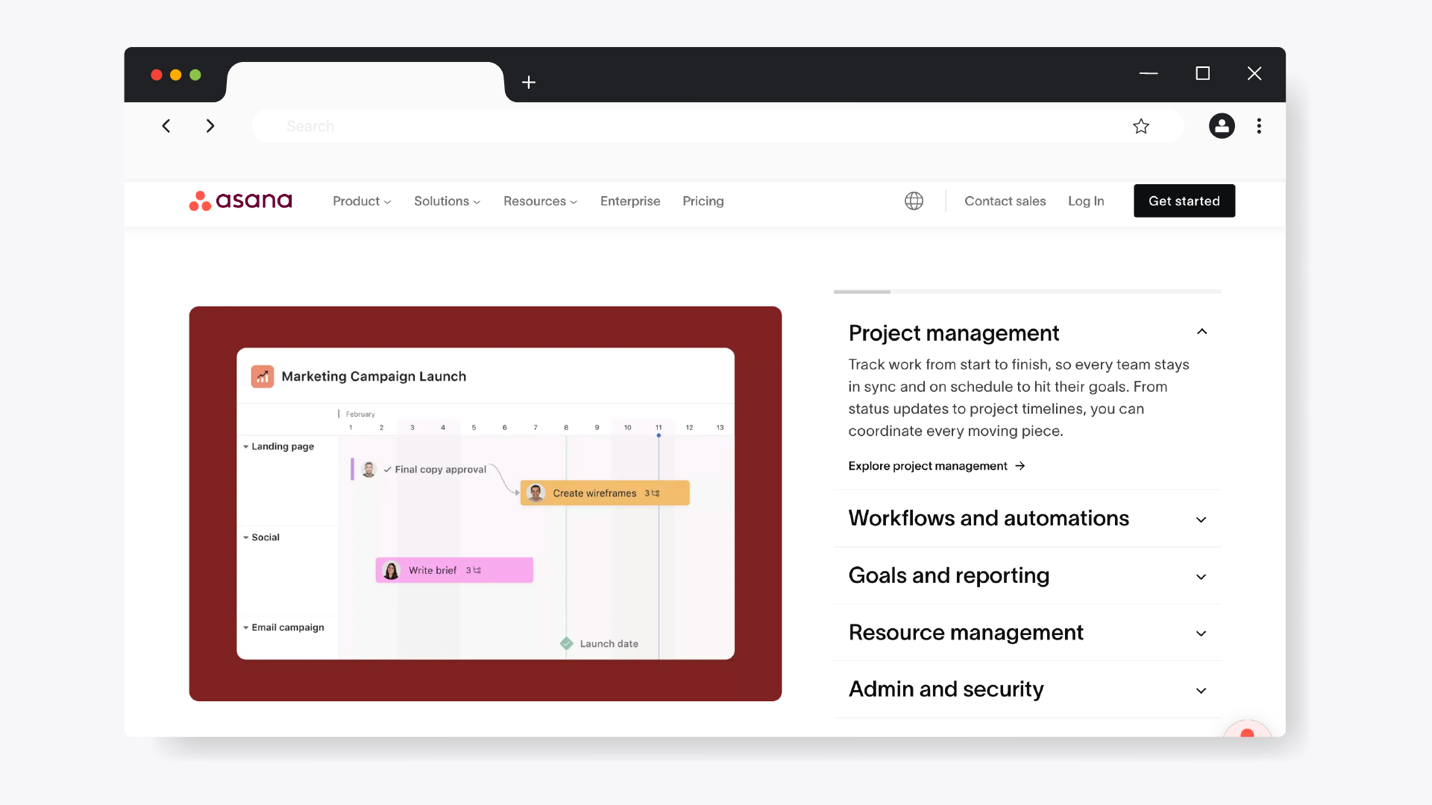
Overview of Asana
Asana is a powerful project management tool designed to streamline workflows and boost collaboration. It offers a user-friendly interface with features like task assignments, deadlines, project timelines, and progress tracking. By central communication and coordinating tasks, Asana helps teams stay on top of projects, improve efficiency, and achieve better results.
Features of Asana
- Task management to break down projects into smaller tasks, assign them to team members, set due dates, and track progress.
- Create, track, and manage projects with various views like lists, boards, calendars, and timelines.
- Fosters collaboration and teamwork through comments, mentions, and real-time notifications.
- Facilitates custom workflows with Asana custom fields, forms, and automation rules.
Pros of Asana
Improved Organization
Asana is a tool for planning and monitoring tasks and projects, allowing your team to stay abreast of work. No more leaving tasks undone, as this app creates a balance that helps get work done.
Enhanced Collaboration
Asana brings teams together and facilitates a seamless collaboration with team members through features like comments, @mentions, and real-time notifications.
Increased Productivity
If time is not well channeled, it fuels unproductivity. Asana helps you streamline workflows and automate repetitive tasks, saving time and boosting productivity.
Cons of Asana
Steep Learning Curve
While Asana has a user-friendly interface, mastering its features can still take some time, particularly for larger teams and complex projects. This complication can make for an unpleasant working situation that could slow down productivity.
Limited Customization
Some users say that though Asana offers custom options, it isn’t as flexible as other project management tools used for specialized workflows.
Limited Reporting Capabilities
While Asana offers basic reporting features, it also lacks reporting abilities. It may not be as robust in advanced analytics and insights as other tools.
Asana Pricing
A free plan is available.
Premium Plan: Starts at $10.99 per user per month (billed annually) or $13.49 per user per month (billed monthly)
Business Plan: Starts at $24.99 per user per month (billed annually) or $30.49 per user per month (billed monthly)
4. Jira Service Management: Best for AI-Powered Service Management
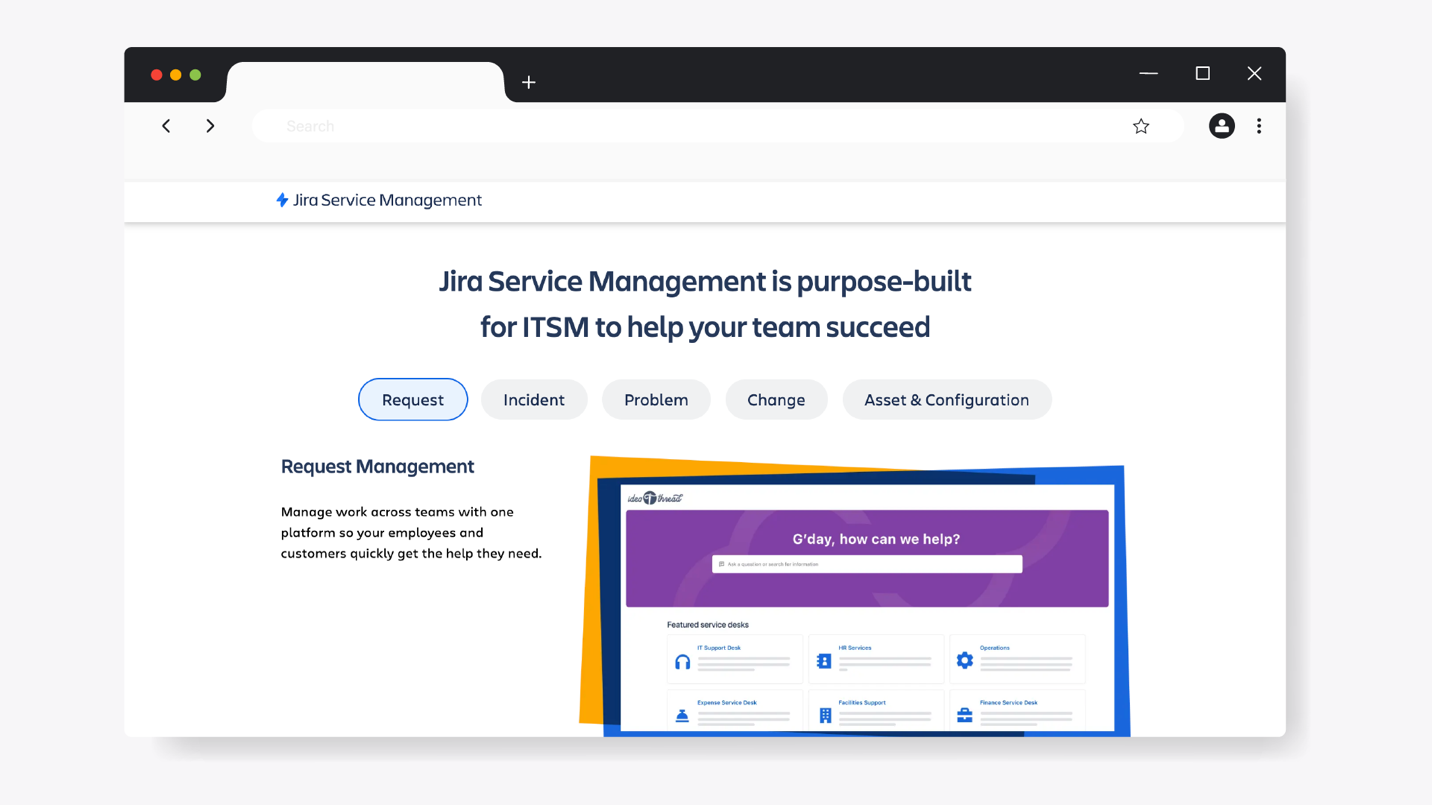
Overview of Jira Service Management
Jira Service Management (JSM) is Atlassian’s powerful service management tool. It makes managing teams and resolving customer requests, incidents, and problems efficient. This tool offers a platform for tracking, managing, and resolving issues, improving service delivery and customer satisfaction. It integrates seamlessly with other Atlassian tools like Jira Software, providing a comprehensive solution for managing the entire service lifecycle.
Features of Jira Service Management
- Efficiently track and resolve incidents, limiting downtime and improving service availability.
- Identify root causes of recurring issues and implement preventive measures to avoid future problems.
- Control and manage changes to IT services, reducing risks and ensuring smooth transitions
- Create and share a central knowledge base, empowering users to find solutions independently and reducing support costs.
Pros of Jira Service Management
Diverse Customization
JSM can be tailored to fit specific workflows and processes, ensuring it aligns with your team’s needs. Though it may not be a great tool for change management, it does serve as a gook workflow tool.
Seamless Integration
It seamlessly integrates with other Atlassian tools, such as Jira Software and Confluence, providing a unified platform for various IT operations.
Facilitates Automation
JSM allows for automating routine tasks, such as ticket assignments and notifications, saving time and reducing errors.
Cons of Jira Service Management
Minimal Reporting Abilities
Though Jira Service Management offers many robust features, one area that could benefit from improvement is its reporting capabilities. While it provides basic reporting functionalities, some areas need additional enhancements that could be valuable.
Complex Configuration
Custom workflows, automated tasks, and a configured system can be complex for beginners or teams without experience in Jira. Some users say that it might require dedicated resources for setup and management. JSM can generate excessive notifications, which could overwhelm end users if not properly configured.
Steep Learning Curve
Some users say that the whole process from the designing phase can sometimes be wonky, as navigating the options is challenging. Also, workflows don’t have external data readily available.
Jira Service Management Pricing
A free plan is available.
Standard and Premium Plan: For the most accurate and up-to-date pricing information, visit the official Atlassian website or contact their sales team.
5. SysAid: Best for IT Service Management

Overview of SysAid
SysAid is a comprehensive IT service management (ITSM) solution with robust change management capabilities. By automating tasks, reducing manual effort, and improving visibility, SysAid helps companies manage changes effectively, limit disruptions, and maintain compliance with regulatory standards.
Features of SysAid
- Comprehensive ITSM capabilities, including incident, problem, change, and configuration management
- Empower end users to resolve issues independently, reducing the burden on IT support.
- Tracks IT assets, software licenses, and hardware inventories
- Enables remote access to end-user devices for efficient troubleshooting
Pros of SysAid
Comprehensive IT Service Management
This tool offers a comprehensive IT management service providing a blend of features, including incident, problem, change, and configuration management.
User-Friendly Interface
Unlike other tools with a steep learning curve, this tool offers an intuitive design and easy-to-use interface for IT staff and end users. Although it is your regular change management tool, it is easy to use and navigate.
Robust Asset Management
SysAid effectively tracks IT assets, software licenses, and hardware inventories. It is undoubtedly the right tool for managing your assets.
Cons of SysAid
Integration Complexities
SysAid’s limited design options restrict how we can tailor the platform to fit specific change management needs. Additionally, the complexity involved in integrating SysAid with other systems often requires significant effort and additional support.
Complex User Interface
Some users say they like the SysAid user interface, but it needs more simplicity and could benefit from a more intuitive design. Also, the self-service portal has had recurring issues, particularly with the password reset function not working as intended.
Complexity in Customization
SysAid occasionally exhibits complexity in customization. While generally user-friendly, certain advanced configurations can be challenging and may require more time for set up.
SysAid Pricing
Free trial plans
Plans start at $79/month
6. Whatfix: Best for Improving Employee Efficiency Website

Overview of Whatfix
Whatfix is a digital adoption platform (DAP) that provides in-app guidance and training for software applications. It helps users learn new software, adopt new processes, and complete tasks more efficiently. It facilitates seamless employee onboarding, feature adoption, and customer support. This tool is compatible with various web and desktop applications, making it versatile for improving user experience and productivity.
Features of Whatfix
- Step-by-step guided tours that highlight key features and actions
- Contextual tooltips that provide real-time assistance while users work
- Task-based checklists to guide users through complex processes
- Shortcut buttons to streamline common tasks
- A central repository of FAQs, how-to guides, and troubleshooting
Pros of Whatfix
Improved User Adoption
One of the top advantages of this software is streamlining employees’ onboarding process. It also helps to reduce training time so that teams have ample time to channel the right energy in the right direction.
Enhanced Productivity
Productivity is needed for effective change management. This tool, therefore, boosts user efficiency and reduces time spent on tasks. This means that work gets prioritized, and the right results will be achieved because of work efficiency.
Cons of Whatfix
Dashboard Clunkiness
Some users have found the dashboard clunky in certain areas, which has caused them inconvenience. They have experienced difficulties navigating and performing tasks efficiently.
Filtering Inconsistency
Several reviewers have mentioned that the filters in the dashboard do not persist when selecting content. This inconsistency hampers their workflow and adds unnecessary frustration.
Analytics Improvements Needed
Users have expressed the need for improvements in analytics functionality. Specifically, they would like the system to remember their selections for a specified time window after choosing a start date. This will enhance their ability to scrutinize data effectively and save time by eliminating repetitive selection processes.
Whatfix Pricing
To get the most accurate and up-to-date pricing information, contact Whatfix directly. They provide a tailored quote based on your specific requirements.
7. Freshservice: Best for Enterprise Service Management
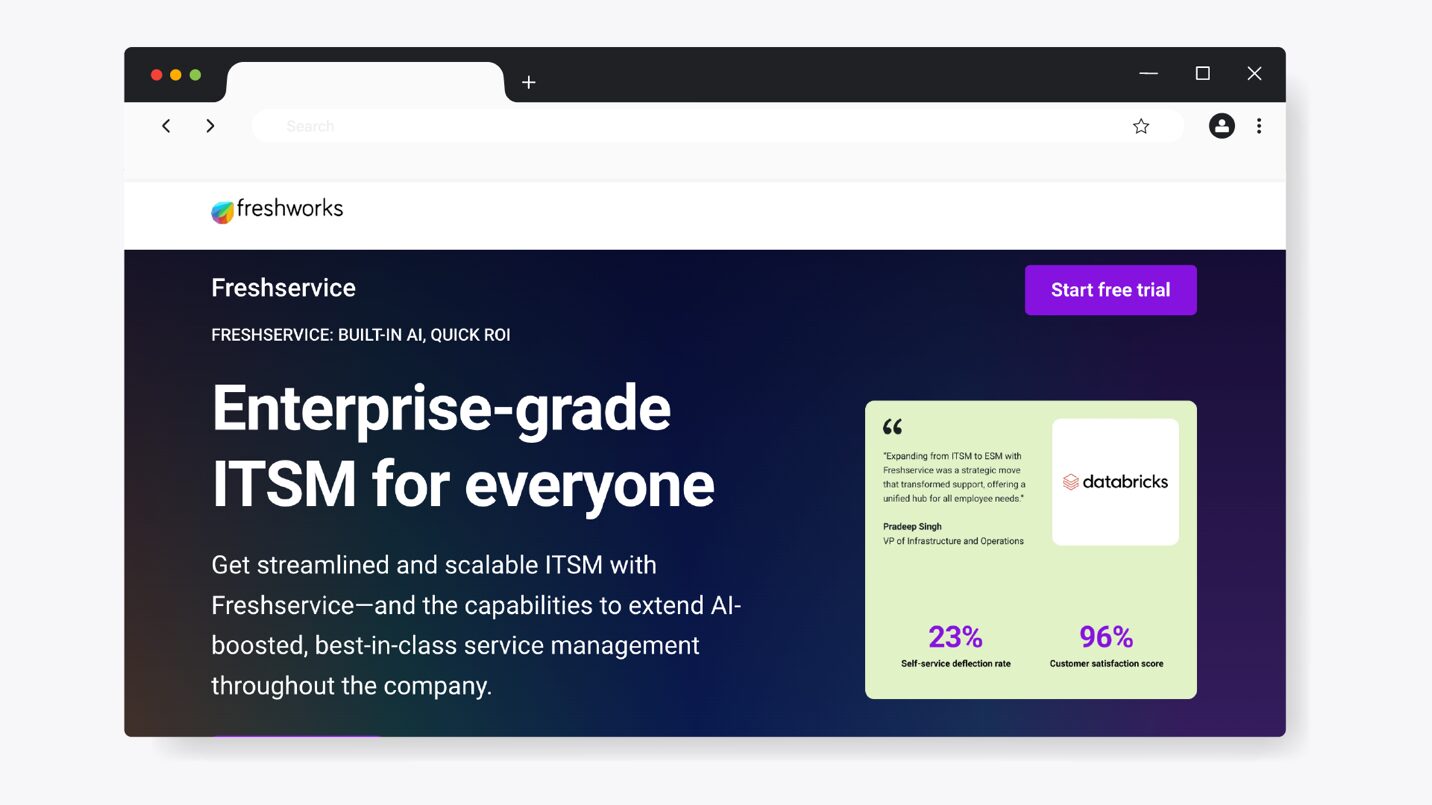
Overview of Freshservice
This cloud-based IT service management (ITSM) solution is designed to streamline IT operations and improve service delivery. It facilitates various services, including incident management, problem management, change management, asset management, and self-service portals. Freshservice helps to automate routine tasks, improve response times, and enhance IT efficiency. Its advanced analytics and reporting provide valuable insights that empower IT teams to deliver exceptional service and support.
Features of Freshservice
- IT service desk that efficiently manages and resolves IT issues through a central ticketing system.
- Asset management abilities, including hardware and software.
- Problem management services include identifying and resolving recurring issues to prevent future problems.
Pros of Freshservice
Comprehensive IT Service Management
When it comes to robust IT service management, you can count on Freshservice. This tool covers incidents, problems, change, and asset management for companies. This means that teams can better collaborate to achieve better working results.
User-Friendly Interface
Beyond software that can manage the IT needs of companies, its user-friendly interface is more important. Freshservice has an intuitive design and easy navigation for IT staff and end-users.
Robust Automation
Manage automation with this tool, as it is tailor-built to automate routine tasks, improving efficiency and reducing errors. This, therefore, makes workflow run smoothly.
Cons of Freshservice
Design Limitations
Some users say they encounter constraints placed on portal design in addition to the requirement of having HTML coding skills. This means the process of developing these pages will require experience and users lack experience, which makes achieving their change management goals fail.
No Remote Service Integration
Users also say that the Freshservice tool offers little or no remote service integration, unlike the SweetProcess tool, which allows seamless integration. This, they say, makes work less interesting.
Lack of Customization
The workflow sometimes doesn’t go smoothly because of the customization laxity. There is also a hitch with changing labels.
Freshservice Pricing
A free trial is available.
Starter plans go for $19, $49, $95, and $119 billed monthly.
8. ServiceNow: Best for Inventory and Supply Chain Management
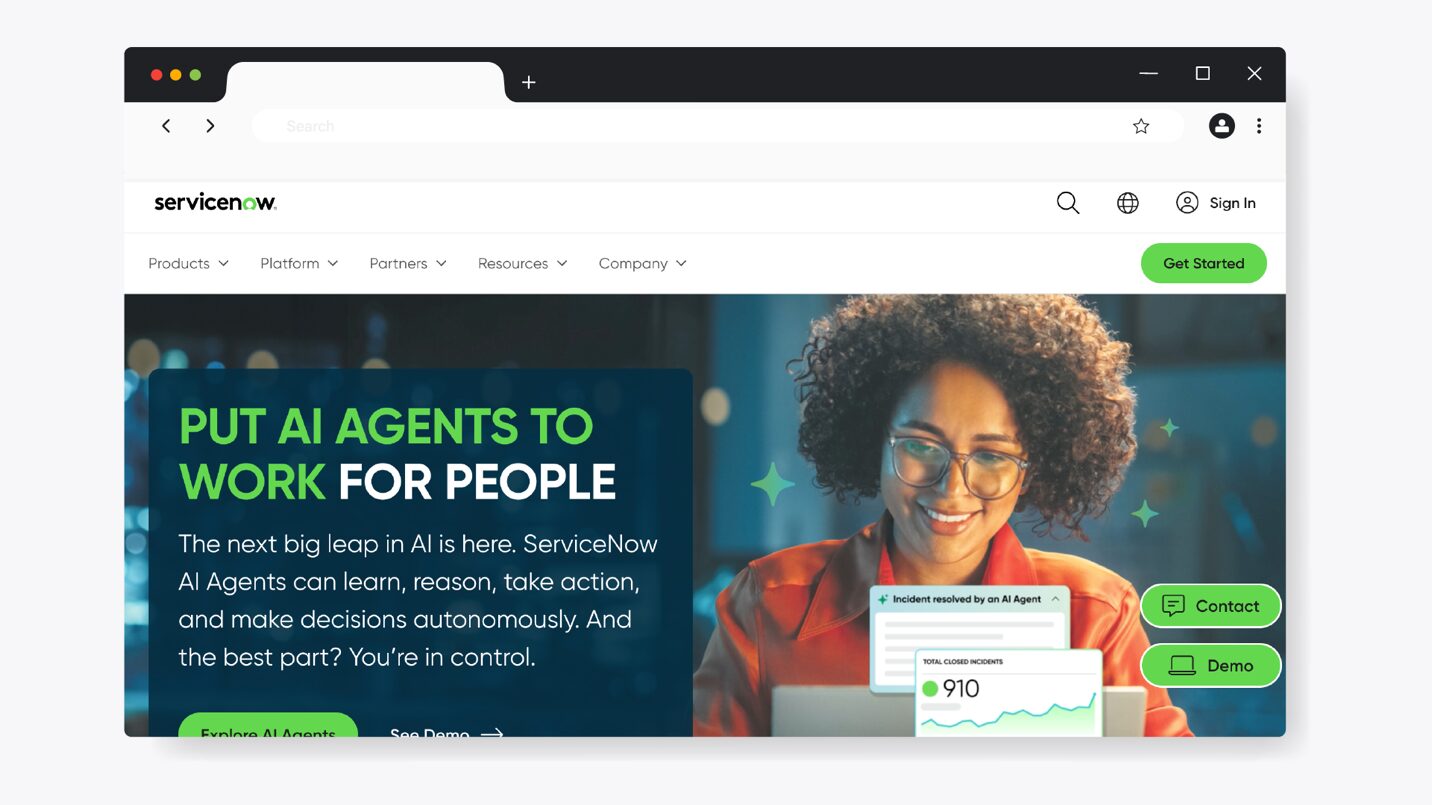
Overview of ServiceNow
ServiceNow is a cloud-based platform that automates IT workflows and improves service delivery. It offers a comprehensive suite of IT service management (ITSM) solutions, including incident, problem, change, and asset management. ServiceNow provides a user-friendly interface, automation capabilities, and integration with other tools to streamline processes and enhance productivity. It helps teams improve efficiency, reduce costs, and enhance customer satisfaction.
Features of ServiceNow
- IT service management tool that handles incidents, problems, changes, and asset management.
- This self-service portal empowers users to resolve issues independently.
- It facilitates the automation of routine tasks to improve efficiency.
- The customer service management (CSM) system manages customer requests, cases, and issues.
Pros of ServiceNow
Comprehensive IT Service Management
This covers incident, problem, change, and asset management. All of these will help manage change in the workplace. By automating routine tasks and workflows, ServiceNow limits errors and ensures consistency, ultimately leading to smoother and more successful change initiatives.
Robust Automation
The ServiceNow tool is good for managing change as its automation ability is top-notch. This tool helps with routine tasks, improving efficiency and reducing errors. ServiceNow streamlines the change process, reduces manual errors, and accelerates implementation. This automation empowers companies to respond quickly to changing business needs while controlling and cutting down risks.
Self-Service Portal
This tool empowers users to resolve issues independently, reducing the IT support burden. This self-service capability helps improve user satisfaction and frees up IT support teams to focus on more complex tasks. Additionally, it promotes a culture of self-reliance and empowers users to take ownership of their IT issues.
Cons of ServiceNow
Lacks Adequate Customization and Integration
Although a change management tool should be able to accommodate workflow designs, this seems lacking. Users say that their level of customization/integration could be improved, making for a clunky and hard-to-navigate process.
Limited Knowledge Base
Some users say that some reporting options are limited. While ServiceNow is a powerful tool, it can be complex to implement and configure, especially for large-scale teams. This complexity can lead to increased implementation costs and longer deployment timelines.
ServiceNow Pricing
To get a precise quote, it’s recommended that you contact ServiceNow directly. They can provide a detailed breakdown of costs, including licensing fees, implementation costs, and ongoing support expenses.
9. Wrike: Best for Work Management

Overview of Wrike
This cloud-based project management and collaboration tool helps teams plan, track, and manage their work. It provides a user-friendly interface and powerful features like task management, project planning, time tracking, and team collaboration. Wrike suits teams of all sizes, from small businesses to large enterprises. It manages a wide range of projects, from simple tasks to complex initiatives.
Features of Wrike
- This task management tool promotes creating, assigning, and prioritizing tasks with due dates and reminders.
- Project feature that helps organize tasks into projects, set deadlines, and track progress
- Team Collaboration feature through comments, attachments, and notifications
- It offers multiple view options like list, board, calendar, and chart to suit your workflow.
Pros of Wrike
Intuitive Interface
Wrike’s intuitive design ensures a smooth user experience, reducing the learning curve and increasing productivity. The clear layout and custom dashboards allow users to find information and manage tasks better easily.
Powerful Collaboration Tools
Wrike facilitates seamless collaboration with team members through comments, attachments, and real-time updates. This one thing promotes seamless collaboration, driving a dynamic and transparent environment where everyone stays on the same page. Imagine a central hub where team members can discuss tasks in real time, share files, and track progress.
Flexible Workflows
This tool offers custom workflows and allows teams to tailor it to their needs. Whether you are managing simple tasks or complex projects, Wrike’s flexibility ensures that it can be adapted to fit your unique workflow. This eliminates the need for rigid, one-size-fits-all solutions and empowers teams to work in a way that suits their style and preferences.
Cons of Wrike
Faulty Integration
Some users say they receive delayed notifications from some integrations. Integrations with apps such as Outlook can delay notifications by over an hour, requiring users to monitor their inboxes. These delays can exceed an hour, potentially leading to missed deadlines and crucial updates. This can disrupt workflows and hinder efficient collaboration.
Lack of a Chat Option
Wrike allows comments on tasks within the context of work. However, users say they rely on third-party integrations such as Slack for easier communication. This can sometimes lead to fragmented communication and require switching between multiple platforms. A built-in chat feature would enhance collaboration and make it easier for teams to discuss tasks and share ideas directly within Wrike.
Wrike Pricing
A free plan is available.
The professional plan costs $9.80 per user per month.
Business plan is $24.80 per month.
10. WalkMe: Best for Digital Adoption

Overview of WalkMe
WalkMe is a leading digital adoption platform (DAP) that helps conglomerates improve software adoption and user experience. With WalkMe, you can create interactive walkthroughs, tooltips, and checklists to guide users through complex processes. It also offers advanced features like user analytics, automation, and integrations with other tools. WalkMe helps reduce training costs, improve user satisfaction, and boost productivity.
Features of WalkMe
- Interactive Walkthroughs that facilitate guided tours that highlight key features and actions
- In-app tooltips that provide real-time assistance while users work
- Task-based checklists to guide users through complex processes
- Smart Tips: AI-powered suggestions that anticipate user needs and provide relevant guidance.
Pros of WalkMe
Enhanced User Adoption
This tool fosters easy streamlining and onboarding to reduce training time, which could hinder its effectiveness. WalkMe empowers users to learn independently at their own pace, minimizing the reliance on traditional training methods and disruptions to workflows.
Improved Productivity
One of the things a change management tool does is boost user efficiency and reduce time spent on tasks. This is exactly what WalkMe does. By eliminating the need for lengthy training sessions and reducing the time spent searching for information, WalkMe empowers users to work more efficiently and achieve their goals faster.
Cons of WalkMe
Time-consuming
Some users say that WalkMe takes up their time because it is difficult to master all functionalities. WalkMe is a comprehensive platform, and its functionalities can be time-consuming, particularly for those not skilled in JavaScript and CSS.
Too Frequent Updates
WalkMe may be difficult to manage during frequent updates. The WalkMe software can be challenging when frequent updates to digital walkthroughs are needed.
Poor Customer Support
Customer support should be top-notch with any change management tool. However, this may not be the case with WalkMe, as users report that the Company’s support team stopped responding to their queries and struggled to finalise their cancellation requests.
Walkme Pricing
A free plan is available.
To get an accurate quote, it is best to contact WalkMe’s sales team.
11. Spekit: Best for Revenue Teams

Overview of Spekit
Spekit is an AI-powered sales enablement platform that benefits teams and helps them access the right information at the right time. It offers in-app guidance, knowledge bases, and AI-powered recommendations to boost productivity and improve sales performance. Spekit seamlessly integrates with popular tools and provides real-time analytics to track user behavior and measure the impact of enablement efforts.
Features of Spekit
- In-house, in-app guidance that provides real-time, context-specific guidance and tips within your team’s daily tools.
- AI-powered recommendations to suggest relevant content and resources based on user behavior and context.
- A content management system to help easily create, organize, and share sales content, including documents, presentations, and videos.
- Analytics reports track user engagement, content usage, and sales performance metrics.
Pros of Spekit
Enhanced Productivity
Spekit helps businesses streamline workflows and reduce time spent on training and onboarding new employees. By providing real-time and context-specific guidance, Spekit streamlines workflows and reduces the time spent training and onboarding new employees. With Spekit, users can quickly learn new tools and processes, leading to faster productivity and improved efficiency.
Improved User Adoption
This tool helps teams accelerate the adoption of new tools and processes. That makes for effective change management. WalkMe addresses this challenge by providing in-app guidance and training, reducing the learning curve, and increasing user engagement. By providing context-sensitive help and step-by-step instructions, Spekii empowers users to quickly become proficient with new systems and workflows, leading to faster adoption and reduced support costs.
Increased Sales Efficiency
This tool has you covered if you want to empower sales teams with the right information at the right time. Spekit ensures that sales reps have the tools they need to succeed. This helps reduce time spent searching for information, accelerate the sales cycle, and drive revenue growth.
Cons of Spekit
Lagging Features
Some users report frustrating delays, especially with the hover feature. This can significantly hinder productivity as users are forced to wait for the page to refresh, interrupting their workflow. Such technical glitches can undermine the platform’s efficiency and user satisfaction.
Steep Learning Curve
Some users may find Spekit’s initial learning curve somewhat steep, particularly those unfamiliar with similar platforms or with limited technical expertise.
Spekit Pricing
Free plan
Basic: $10/user per month
Premium: $20/user per month
What Is Change Management?
Change management is a structured approach for managing and implementing changes in processes and policies. It involves specific steps and strategies to ensure a smooth transition that eliminates resistance. This process is key for businesses of all sizes and industries to successfully implement standard changes with minimal disruptions.
8 Benefits of Change Management Software

Smoother Transitions
A change management software can centralize change requests, automate approval workflows, and track progress. This allows you to schedule changes effectively, assess potential impacts, and communicate updates to stakeholders. By providing smoother transitions, risks are reduced, minimal disruptions occur, and smoother implementations are guaranteed.
Enhanced Communication
Change management software facilitates enhanced communication by providing a common platform for sharing information, updates, and notifications. It enables real-time collaboration among team members, stakeholders, and customers.
Florinela Serban, the head of operations at Onogo, an e-commerce business that offers a wide range of consumer products at competitive rates, was responsible for streamlining the business processes at Onogo until she found SweetProcess.
SweetProcess presented Onogo with a platform to document the procedures and bring all the teams on board. It also provides an option to get all the information in one place and reduce resistance to change.
Increased Productivity
Change management software significantly eliminates manual labor by streamlining processes and automating tasks like change request submission, approval workflows, and impact assessments, which saves time and errors. There are central repositories for change documentation and knowledge bases, which improve collaboration and knowledge sharing among teams.
Improved Employee Morale
Change management software significantly boosts productivity by streamlining processes and reducing manual efforts. Automating tasks like change request submissions, approval workflows, and impact assessments saves time and eliminates errors. Common repositories for change documentation and knowledge bases improve teamwork and tribal knowledge within teams.
Faster Adoption
Effective communication is always needed to manage change and is what change management software fosters. It enhances communication and central information, automates tasks, and provides real-time updates, reducing confusion and delays. This way, automated workflows and clear communication channels keep stakeholders informed and engaged.
Cost Savings
Change management software helps save costs, thereby reducing risks and improving efficiency. This software mitigates risks associated with change to avoid costly disruptions and failures. It also enables teams to measure the impact of change initiatives and resource allocation and ensure maximum ROI.
Enhance Customer Satisfaction
Change management software facilitates direct communication about upcoming changes, surprises, and anxiety. Providing timely updates and addressing concerns proactively builds trust and fosters a positive customer experience. The software also helps identify potential impacts on customers and implement mitigation strategies, reducing disruptions and improving overall service delivery.
Regulatory Compliance
Change management software aids in automating tasks, tracking regulatory changes, assessing the impact of new regulations, and ensuring comprehensive documentation for audits and reviews, all of which promote regulatory compliance.
Sign up for SweetProcess for free for the next 14 days and enjoy all these benefits and more.
7 Things to Consider Before Choosing a Change Management Software for Your Business

Workflow Automation
Consider a change management tool like SweetProcess that facilitates change request creation, assignment, approval, and implementation to achieve faster time-to-market, improve efficiency, and enhance visibility into the change process.
Cross-Functional Collaboration
A change management tool fosters cross-functional collaboration by breaking down silos and promoting a culture of collaboration. It also provides a central platform for communication, task assignment, and progress tracking.
This allows teams from different departments to share information and updates, collaborate on tasks, resolve issues, track dependencies, ensure alignment, and access shared documentation and knowledge bases.
Robust Analytics and Reporting
Change management tools provide robust analytical capabilities to change initiatives. Like SweetProcess, these tools offer impact analysis, risk assessment, and progress tracking. They help map the change process, identify potential bottlenecks, and measure the effectiveness of strategies.
Integration
Change management plays an indispensable role in facilitating integration within an organization. By promoting a shared vision and involving key stakeholders from various departments, it breaks down silos and drives cross-functional collaboration. Effective communication is essential to keep everyone informed and aligned, cutting back on misunderstandings and fostering trust.
Change Approval Customization
Change management tools are built to allow approval workflows. Some of the actions change management tools track include defining the number of approvers, their order, and the specific criteria for approval. Some tools even allow for dynamic routing, where the approval path is determined based on the nature and impact of the change.
Flowcharts & Process Maps
Change management tools are hardwired to help map out existing workflows and pinpoint areas with bottlenecks and inefficiencies. These visual tools help document current processes, identify areas for improvement, and foresee proposed changes.
Learning Management & Skill Building
Change management tools often include features that support creating a knowledge base and training modules. The knowledge base is a central repository of information, procedures, and best practices related to change management. The training modules are built to educate users on change management principles and tools.
How Companies Implement Organizational Changes Using SweetProcess

Phase Out Archaic Change Management Processes
Jonathan Harvey, chief operating officer at Neon Buddha, a fashion brand, was bothered by how employees struggled with complex processes in the company. As a fast-growing fashion brand, to be more effective, he and his team were always looking to have as many SOPs as possible, but they lacked the know-how—until they found SweetProcess.
The turning point in his business came when he could schedule recurring tasks and track changes in day-to-day procedures and policies. SweetProcess has better positioned Jonathan’s business to scale quickly and efficiently, establishing its global presence.
Streamline Change Management Processes
Luke Pickerill, president of MonteVista Homes, tried to change his organization’s faulty operational processes. Day-to-day operations became more complicated as his team worked without change management software. He soon found that simply documenting the business processes that initiate change within an organization was not enough; the impact lies in how well you manage the documentation.
After he started using SweetProcess, he found the missing piece of the puzzle. Now, they can develop effective processes and onboard new employees who will learn about the job tasks and functions specific to their roles.
Which Change Management Platform Is Right for Your Company?

Every forward-thinking founder and team should consider adopting change management tools. SweetProcess provides everything required to manage change in your company so that you can increase scalability and profits. When you adopt SweetProcess as your foremost tool for driving change management, you can join the success stories that have come out of it.
Sign up for a free SweetProcess trial without a credit card, and feel free to cancel anytime.
